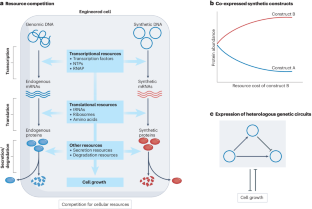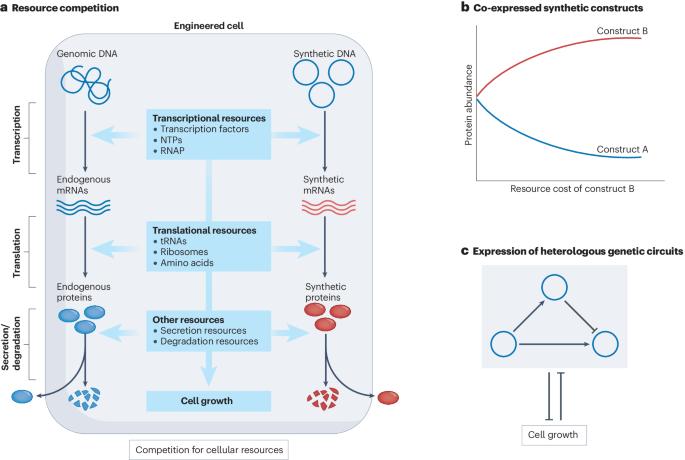Understanding resource competition to achieve predictable synthetic gene expression in eukaryotes
IF 37.6
引用次数: 0
Abstract
Synthetic gene expression in engineered cells typically depends on the host cell’s limited pool of intracellular resources, which can lead to resource competition between native and engineered functions and may cause unanticipated effects in the host and synthetic gene circuit. For example, competition for shared resources may lead to cellular overload affecting physiological functions (that is, cellular burden) and negatively affect synthetic construct performance to the point of unreliability. This fundamental problem has implications for the use of synthetic genetic constructs in cell engineering for foundational research, therapy and bioprocessing. Resource competition has mainly been investigated in model bacteria systems, but also considerably affects eukaryotic systems, including mammalian cells. In this Review, we discuss resource competition beyond bacteria, outlining how it can lead to gene expression coupling, gene expression and metabolic burden. We also examine ways to quantify cellular burden in mammalian cells, and investigate circuit-centric and host-centric mitigation strategies, highlighting important implications of resource competition for cell engineering in therapeutic and bioproduction applications as well as in fundamental biology studies. Cell engineering by synthetic biology typically relies on synthetic gene constructs that compete with the host cell for intracellular resources. This Review discusses how such resource competition can impact mammalian cell engineering and outlines strategies for how to mitigate cellular burden using circuit-centric and host-centric approaches.


了解资源竞争,在真核生物中实现可预测的合成基因表达
工程细胞中合成基因的表达通常依赖于宿主细胞有限的细胞内资源库,这可能导致原生功能和工程功能之间的资源竞争,并可能在宿主和合成基因回路中造成意想不到的影响。例如,对共享资源的竞争可能会导致细胞超载,影响生理功能(即细胞负担),并对合成构建物的性能产生负面影响,甚至达到不可靠的程度。这一基本问题对细胞工程中合成基因构建体在基础研究、治疗和生物加工中的应用具有影响。资源竞争主要在模式细菌系统中进行研究,但也对真核系统(包括哺乳动物细胞)产生很大影响。在本综述中,我们将讨论细菌以外的资源竞争,概述资源竞争如何导致基因表达耦合、基因表达和代谢负担。我们还探讨了哺乳动物细胞中量化细胞负担的方法,研究了以电路为中心和以宿主为中心的缓解策略,强调了资源竞争对治疗和生物生产应用中的细胞工程以及基础生物学研究的重要影响。
本文章由计算机程序翻译,如有差异,请以英文原文为准。
求助全文
约1分钟内获得全文
求助全文

 求助内容:
求助内容: 应助结果提醒方式:
应助结果提醒方式:


